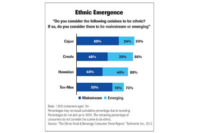Driving the Popularity of Ethnic Flavors
Shipments of curries and chili peppers to foodservice outlets grow by double-digits

Cultural influences and the more adventurous taste buds of US consumers have made flavors like tikka masala, poblano, and doenjang recognized names on grocery store shelves and restaurant menus. The affinity US consumers continue to show for ethnic flavors and dishes is supported by the fact that 755 of US adults, especially young adults, are open to trying new foods, reports The NPD Group, a leading global information company.
When consumers dine out they want to see hot, garlic, and spicy flavors and foods on menus. Dollars of total spices and seasonings shipped from broadline foodservice distributors to restaurants and other foodservice outlets increased by 75 versus year ago in the year ending March 2017, according to NPD’s SupplyTrack®, a monthly tracking service that tracks every product shipped from major broadline distributors to their foodservice operators. Among the top growing spices and seasonings being shipped to independent restaurants and commercial and non-commercial foodservice outlets are curries, examples of which are tikka masala and yellow curry, which grew by 115, and chili peppers, like aleppo and habanero, which grew by 125.
At home there is a rise in homemade Asian and Hispanic dishes and use of more flavorful items like chili peppers. Mainstream Asian flavors include fish sauce, doenjang, garlic chives, ginger and lapsang souchong, finds NPD’s continual tracking of US consumers’ eating habits. Among the growing and emerging Asian flavors are Asian pear, galangal, lychee, mango, and papaya. When it comes to Hispanic flavors jalapeno, habanero, ghost pepper, and mole negro are mainstream. Hibiscus, dragon fruit, mammee, and bitter orange are among the emerging and growing Hispanic flavors and foods found in US kitchens.
“The growing Asian and Hispanic populations in the US have introduced new flavors into the American diet and many of these flavors are now mainstays in our kitchens and on menus,” says Ann Roberts, vice president, SupplyTrack. “There are also new flavors and flavor profiles emerging and growing, which makes it important for distributors, manufacturers, and foodservice operators to understand the impact of ethnic cultures and their related flavors in order to recognize growth opportunities.”
Looking for a reprint of this article?
From high-res PDFs to custom plaques, order your copy today!








